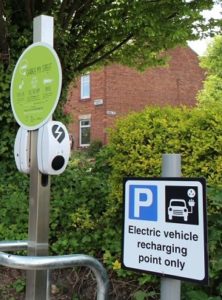The need for public EV charging
The UK’s switch to EVs is accelerating to reduce emissions, meet climate change targets, and improve air quality.
A mass transition to electric road transport can only happen if supported by development of a fit-for-purpose public charging network nationally.
This network needs to:
- give drivers the confidence to switch to electric
- be socially-inclusive, offering realistic access to the EV transport revolution for all residents and visitors across Cumbria

Types of EV chargepoints
In contrast to the traditional petrol and diesel forecourt, a fit-for-purpose national charging network will require a broad mix of different public and private types of charging solutions will be needed.
Sites listing such as Zap-Map (https://www.zap-map.com/) which list public chargepoints show that this diverse network is emerging, but also demonstrate the scale of what will be needed to support the switch to electric.
Public charging infrastructure is generally installed either by chargepoint network operators or by host site organisations, with sometimes a joint approach taken to supplying / fitting / operating the equipment.
EV drivers generally meet their various charging needs through a combination of:
Home charging
If you have off-street parking, such as a private garage or driveway, you can have a chargepoint installed at home. This will generally be a 3-7kW slow charger, based on a typical domestic single phase AC supply, sufficient for overnight charging.
Destination & community charging
While you’re out and about, you can use chargepoints at shops, cafes, offices or in the community. These are typically 7-22kW fast chargers. Depending on the vehicle, you can add 50-80 miles’ range in 1-3 hours.
Electric forecourts
Think of a petrol station, but with chargepoints instead of petrol pumps. That’s an electric forecourt. More of these are starting to pop up around the UK, such as Gridserve and Shell Recharge. They typically have DC rapid/high-power chargers of 44kW-350kW. Depending on your car, these chargers are capable of delivering a full charge in as little as 30 minutes.
What will Cumbria's charging network look like?
It’s vital that the exciting opportunity to move to electric transport is fully recognised and realised here in Cumbria, and that appropriate leadership is shown to ensure a fit-for-purpose charging network emerges to support the switch.
For those responsible for infrastructure planning, approaching charging provision in a wholistic way can offer considerable benefits for procurement and standardisation.
Find out more with our analysis report forecasting Cumbria’s requirements for public EV chargepoint rollout over the coming decade.
Range Anxiety
Range anxiety is the name given to the fear EV drivers have of having their battery run out, leaving them stranded with nowhere to charge their car up.
This is usually brought up as a reason for putting off the decision to switch to an EV by non-EV drivers. To see how bad this phenomenon is, we spoke to four experienced EV drivers and asked them how they get around it.
